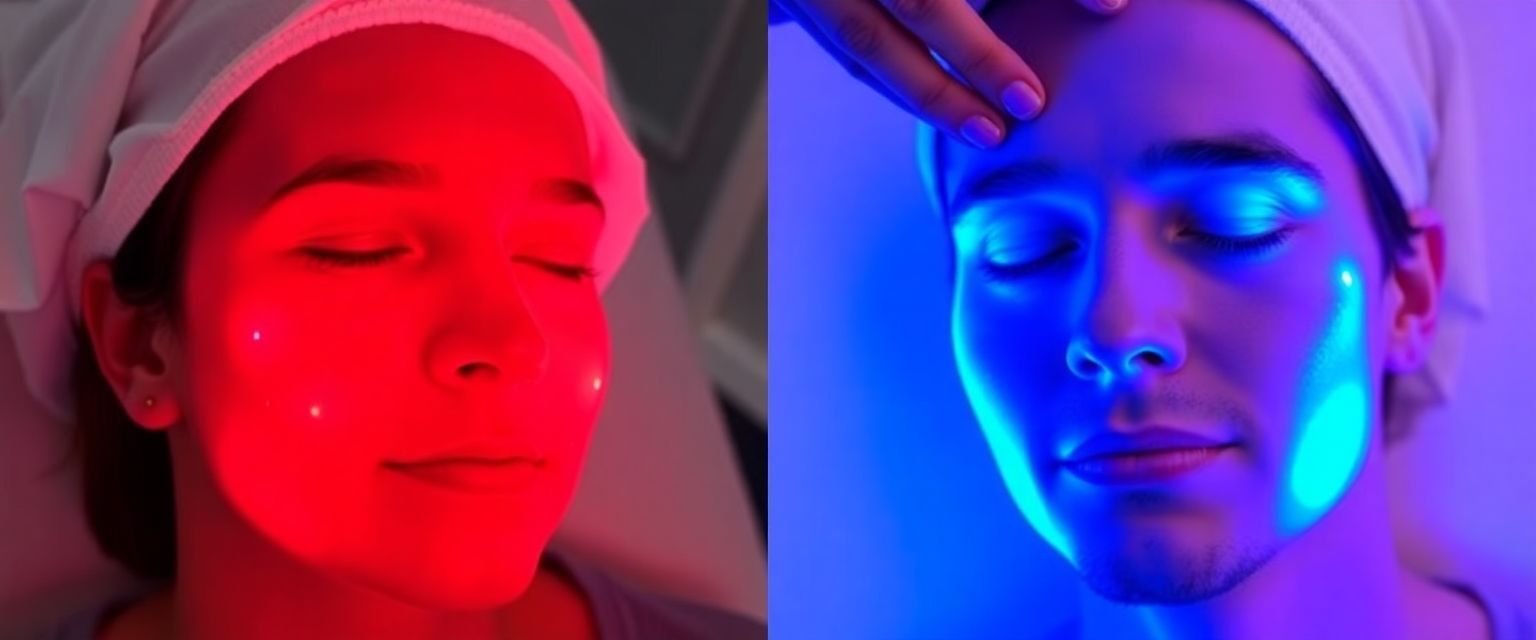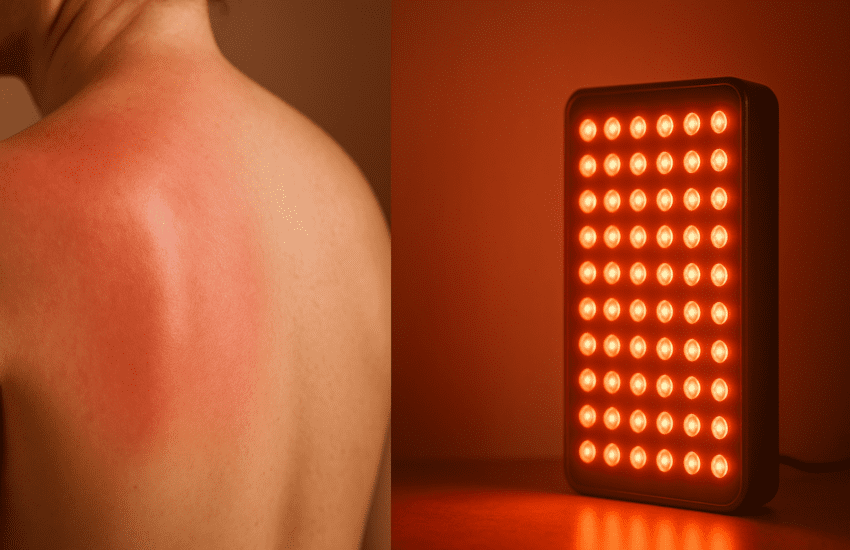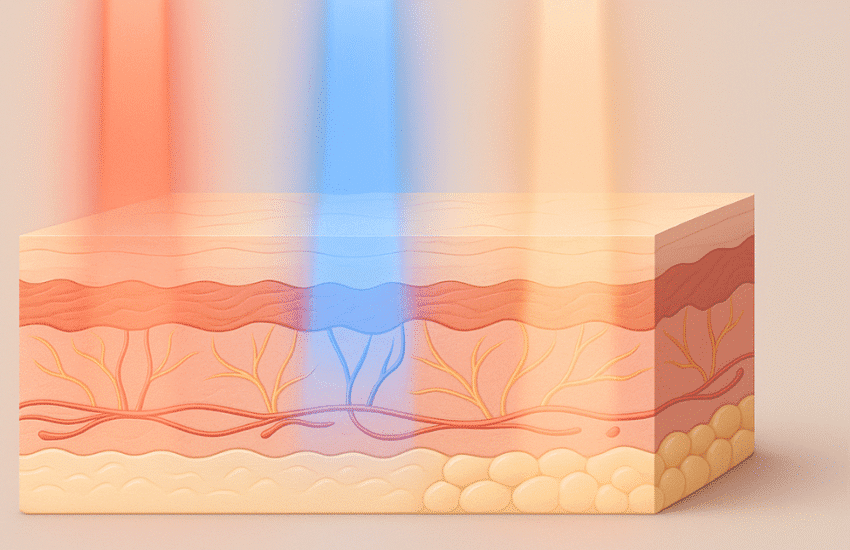What is the Difference Between Red and Blue Light Therapy?
Light therapy has changed the game for skincare and wellness. The difference between red and blue light therapy lies primarily in their wavelengths and what they target in your body: red light dives deeper into your skin to boost cell repair and calm inflammation, while blue light stays closer to the surface to zap acne-causing bacteria.
If you’re trying to decide which one fits your needs, it helps to know how each wavelength works, what benefits they offer, and how they’re typically used. With that information in hand, you can pick the light therapy that best supports your skin and health goals.
Red vs Blue Light Therapy: Which Wavelength Works Best for Your Skin?
You know that warm, energizing feeling you get from morning sunlight? Red light therapy taps into that same biological response, but with laser-focused precision. This targeted photobiomodulation approach uses specific wavelengths (typically 630-660nm) to wake up your cells and get them producing energy more efficiently.
When these red wavelengths hit your skin, they kickstart collagen synthesis—that protein responsible for keeping your face looking plump and youthful. The light penetrates deep enough to reach the dermis, where collagen lives, making it perfect for anyone wanting to smooth out fine lines without needles or downtime.
Here’s what makes red light special: it calms inflammation throughout your body by regulating cytokines and boosting circulation. Athletes swear by it for post-workout recovery because those 810-850nm near-infrared wavelengths reach deep into muscle tissue and joints.
I’ve seen people experience remarkable improvements with thinning hair too. The red light appears to wake up dormant follicles on the scalp, encouraging new growth. Most sessions take just 10-20 minutes—you stand or sit in front of an LED panel while the light does its work.
Blue Light Therapy for Acne: How Surface-Level Treatment Clears Breakouts
That stubborn pimple showing up before an important meeting might have met its match in blue light therapy. While red light dives deep, blue wavelengths (405-495nm) work right at your skin’s surface where acne-causing bacteria love to hang out.
Blue light specifically targets P. acnes bacteria—those microscopic troublemakers behind inflammatory breakouts. The wavelengths create a photodynamic reaction that destroys these bacteria without harming your healthy skin cells. For anyone dealing with mild to moderate acne, regular LED therapy sessions can clear skin without the harsh drying effects of benzoyl peroxide.
Research shows blue light therapy offers benefits beyond acne control. During winter months, controlled exposure helps regulate circadian rhythms and can lift your mood when daylight becomes scarce.
Treatment sessions run 15-30 minutes, depending on your specific concerns. You might notice a gentle sensation as the blue light works on reducing oil production and eliminating bacteria at the surface level.
Key Differences in Light Therapy Penetration Depth and Applications
Think of different light wavelengths as keys that unlock specific doors in your body. Red light acts as a master key, penetrating up to 10mm beneath your skin’s surface to reach deeper tissues. Blue light functions more like a surface cleaner, working within the first 1-2mm of skin.
This penetration difference explains why each light therapy excels at different tasks. Red light therapy for wrinkles works better because it reaches the deeper dermal layers where collagen production happens. Its warming energy stimulates mitochondrial function in cells throughout multiple tissue layers.
Blue light’s antibacterial properties are better suited for treating surface conditions. Since it stays in the epidermis, it perfectly targets sebaceous glands and bacterial colonies without affecting deeper structures.
Results timelines vary between the two therapies. Blue light often shows improvements in acne within 2-4 weeks of consistent use. Red light therapy results for anti-aging typically appear after 8-12 weeks as collagen remodeling takes time.
Both LED light therapy types maintain excellent safety profiles. Unlike UV radiation from tanning beds, neither wavelength damages DNA or increases cancer risk when used as directed.
Combining Red and Blue Light Therapy for Maximum Skin Benefits
Sometimes pairing treatments creates better outcomes than using either alone. Think of combination therapy as having both offense and defense in your skincare routine—blue light eliminates bacteria while red light heals and boosts tissue regeneration.
For inflammatory acne sufferers, this dual approach can be game-changing. Blue wavelengths destroy P. acnes on the surface while red light reduces the painful inflammation that makes cystic breakouts so uncomfortable.
Many dermatology practices now offer professional light therapy treatments using devices that deliver both wavelengths. Some alternate between colors during a single session, while others recommend using different wavelengths on different days.
Nowadays, at-home photobiomodulation devices often combine multiple wavelengths. I’ve seen a friend finally clear her adult acne and smooth her skin’s texture with this approach—results she couldn’t achieve after years of topical treatments.
Choosing Between Professional Light Therapy Treatments and Home Devices
Selecting the right light therapy approach resembles choosing between professional hair color and a home kit—both work, but with different intensities and commitments. Professional LED therapy for skin rejuvenation typically uses more powerful outputs, potentially delivering faster results.
Your skin sensitivity plays a role in device selection. Starting with lower intensities helps your skin adjust gradually.
Clinical light therapy sessions offer medical-grade equipment and expert guidance but require appointments and higher per-session costs. Light therapy at-home devices provide convenience and long-term savings, though achieving similar results may take more consistent use.
Before starting any light therapy for skin texture improvement, consider consulting a dermatologist. They can assess your specific concerns—whether it’s aging, acne, or rosacea—and recommend appropriate treatment protocols based on your skin type and medical history.
Light Therapy Treatment Protocols: Frequency and Duration Guidelines
Red light therapy for pain and skin rejuvenation works like exercise—consistency matters more than intensity. The mitochondrial stimulation from red wavelengths builds gradually, with most people using their devices 3-5 times weekly for optimal collagen production.
Blue light therapy maintenance for acne control typically requires 2-3 sessions per week. Since you’re targeting bacterial populations that regenerate quickly, regular treatments prevent new colonies from establishing themselves.
Wavelength selection impacts session length too. Red light treatments often run 10-20 minutes per area, allowing time for cellular energy production to increase. Blue light sessions might extend to 30 minutes when treating larger areas or stubborn breakouts.
Many light therapy clinical studies suggest starting with shorter sessions and gradually increasing duration as your skin adapts. This approach minimizes any potential blue light therapy side effects like temporary dryness or mild irritation.
Red Light Therapy at-Home Options vs Clinical Settings
Home Devices
Home photobiomodulation panels have made red light therapy more accessible and affordable. Today’s at-home units deliver the same healing wavelengths you’d find in a clinic—just at a lower power density. Once you cover the upfront cost (often a few hundred dollars), you’ll recoup your investment after about 10–20 professional sessions. Plus, you can treat yourself anytime, without booking an appointment.
Clinical Settings
Professional light therapy centers use higher-powered equipment and offer personalized care. Technicians tailor your treatment plan, may combine red or blue light therapies, and track your results with specialized imaging tools. This hands-on approach can accelerate improvements in skin health, pain relief, or other targets.
Cost and Convenience
- Home Devices: Higher initial cost, then essentially free maintenance. Ideal for daily use and long-term savings.
- Clinical Sessions: Pay-per-visit adds up—typically $50–$150 per session—but you get expert guidance and more powerful light output.
Insurance Coverage
Most insurers classify light therapy as cosmetic, so coverage is rare. Exceptions include:
- Blue Light Therapy: May be covered for prescription treatment of severe acne.
- Red Light Therapy: Sometimes approved for FDA-cleared pain relief protocols.
By weighing upfront investment, treatment power, and professional support, you can choose the light therapy option that best fits your skin and wellness goals.
Light Therapy Wavelengths Comparison: Understanding the Science
The magic happens at the cellular level, where different wavelengths trigger unique biological responses. Red light at 630-660nm optimizes superficial collagen synthesis, while near-infrared at 810-850nm penetrates deeper for muscle and joint relief.
Blue light’s 405-495nm range specifically matches the absorption spectrum of porphyrins produced by acne bacteria. This creates a photochemical reaction that destroys bacterial cell walls without affecting surrounding tissue.
Research into light therapy for wound healing reveals how red wavelengths accelerate tissue repair by increasing ATP production and improving circulation. Athletes using red light for muscle recovery report reduced soreness and faster return to training.
Blue light affects chronobiology differently, influencing melatonin production and alertness patterns. This explains why blue light therapy for seasonal affective disorder works—it helps reset disrupted circadian rhythms during darker months.
Conclusion
Light therapy offers a scientifically-backed, non-invasive approach to various skin and health concerns. Whether you choose red light’s deep-healing properties, blue light’s surface-level bacterial control, or combine both for comprehensive treatment, consistency remains your best friend.
These therapies work best as part of a complete skincare routine. Continue cleansing, moisturizing, and protecting your skin from sun damage while incorporating light therapy into your regimen.
As research continues expanding our understanding of photobiomodulation, current evidence strongly supports using specific wavelengths for concerns ranging from aging and acne to pain management and mood regulation. Work with a healthcare professional to develop a personalized protocol that addresses your unique needs and complements your existing treatments.
FAQs
Is blue light therapy better than red light therapy?
Blue light therapy isn’t “better” overall—it’s more effective at killing acne-causing bacteria on the skin’s surface, while red light is better for reducing inflammation and promoting cellular repair. Choose based on your specific concern.
What happens if blue light is used instead of red light?
Using blue light instead of red light will target surface bacteria without delivering the deep-tissue repair and anti-inflammatory benefits that red light provides, so you may not see improvements in healing or collagen production.
Should you do red light or blue light first?
Most protocols recommend starting with blue light to clear bacteria and surface concerns, then following with red light to soothe inflammation and stimulate deeper repair.
What are the downsides of blue light therapy?
Blue light therapy can cause skin dryness, redness, or sensitivity in some users, and overuse without proper cooling or eye protection may increase the risk of skin irritation.
What color light is best for sleep?
Red light is best for sleep because its wavelength doesn’t suppress melatonin production and can help promote relaxation and a healthy circadian rhythm.


